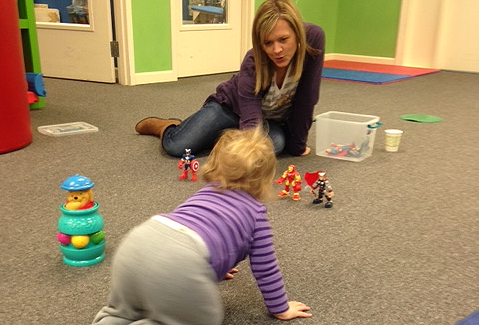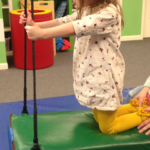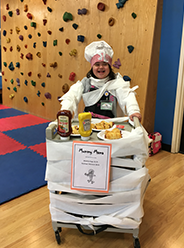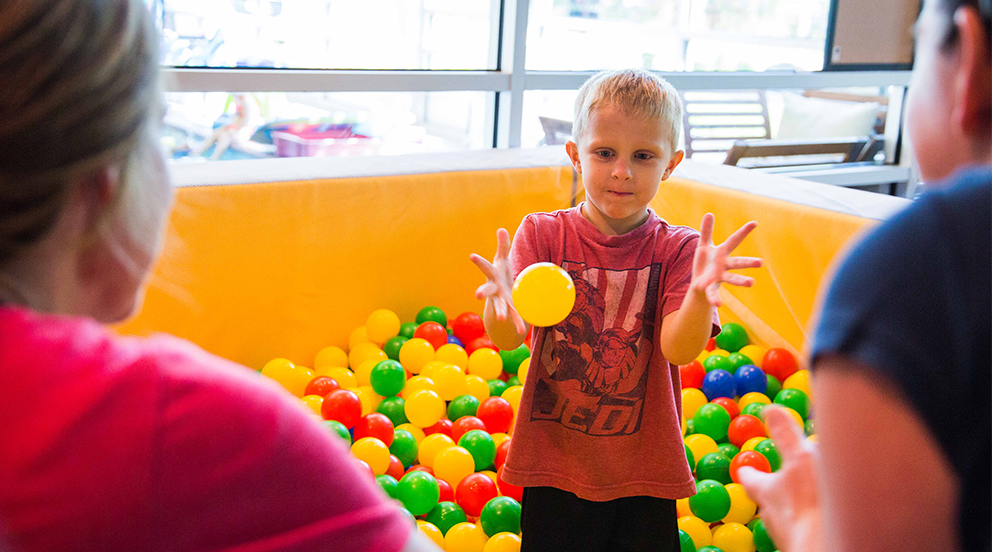We pediatric therapists have, in my opinion, the coolest jobs on the planet! I mean, who gets to go to work every day in an office where trampolines, swings, ball pits, doll houses, crayons, and glitter are all standard pieces of equipment?
We play with children all day. And this is not just playing with a large group of children at a time. We have the privilege of giving each child our 100% attention, and they (hopefully) give us this love and attention right back.
Play is how a child grows intellectually, socially, and emotionally. Truly, it is the “work” of children. And it is our job, as pediatric therapists, to incorporate therapy activities into a play format for your children.
The goal of each occupational, physical, and speech therapist is to help each and every child to meet his/her maximum functional potential. We want your child to be able to sit at the dinner table and have a conversation with his family.
We want him to attend to his teacher and learn new things. We want him to be able to run and jump and play with his friends on the playground. We want him to build relationships with his peers and have a successful academic and social career. All of these skills can be targeted through play in the early years.
We have all heard the criticism from various people that all we therapists do is “just play” with the children. Many parents, family members, politicians, and others think that all we do is simply play with children, and that they could do the same things themselves at home. This is where our years of schooling and experience come into account. This is where OT, PT, and ST are skilled disciplines and not just those people you see “playing” with your children.
PHYSICAL THERAPY “PLAY”
The primary focus of pediatric physical therapy is to improve a child’s gross motor skills in order to improve his/her ability to move about in his environment. But what is an environment for a child? It is not just home, work, store, like it may be for many adults. Children also need to be able to participate on the playground, in P.E class, and even on the soccer field if they so choose. The point is, yes, PT is about walking/mobility, but it is also about having the gross motor skills to participate in a variety of activities and environments.
So, in the past few weeks, I sat in the PT gym and observed a few of our TEAM PT’s “playing” with their clients. Here are some of the fantastic activities I saw!
Therapy ball
Wade Cunningham, a member of our PT TEAM, had a giggly young man sitting and bouncing on a large therapy ball, and then later laying on his stomach on this same therapy ball and “flying like Superman.” Play? Yes, but this was also working on dynamic sitting balance, trunk strength and control, and transitional movements from sitting to laying and back to sitting again. Much more fun than sit-ups!
Obstacle course
Danielle Cunningham, another member of our PT TEAM, had a girl walking on balance beams, hopping on one leg, skipping, jumping up on benches, all very “Super Mario Brothers Style.” Fun, right? True, but all of this jumping works to improve strength in leg muscles, balance, endurance, jumping skills, and overall motor planning and coordination skills.
Snuggling
I frequently see therapists “snuggling” young clients in the gym area. Snuggling makes all of us feel warm and fuzzy, but how does that help therapy goals? Well first, it is important to establish rapport with all clients, and snuggling is a great way to establish rapport with very young clients/infants. And when young clients are taking a rest break from their exercises, what do they often want? Simple hugs in your lap, that’s what.
But the snuggles are not all touchy-feely. Sometimes they are actually therapy exercises. Often when a physical therapist appears to simply be loving on a child, she is often trying to relax the child while simultaneously performing gentle resistive stretching. I observed TEAM physical therapist Holly Hill snuggling a child during his rest break from running. “Snuggling?” I asked. “No,” she replied, “I’m monitoring his heart rate and respirations.” Oh, right. I stand corrected. Not just snuggling.
Crawling
Physical therapist Christie Summerford had a cute little one crawling all over the floor, getting into all kinds of toys.

This is just fun “hanging out” with a little one, right? No. What about older kiddos – crawling around, pretending to be different animals? All fun and games? Not hardly. Crawling is such an important exercise! Crawling works on hand, arm, and shoulder strengthening, coordinating right/left sides of the body, trunk/neck strength, integrating the primitive reflexes that should disappear in infancy… The list goes on and on!
Swinging
 Delinda Floyd had an adorable little girl tall-kneeling on the swing. Swinging as exercise? Of course! Physical therapists position their clients in many different positions while on the glider or platform swing, including tall-kneeling, half-kneeling, ring-sitting, quadruped (on hands and knees in a crawling position), etc.
Delinda Floyd had an adorable little girl tall-kneeling on the swing. Swinging as exercise? Of course! Physical therapists position their clients in many different positions while on the glider or platform swing, including tall-kneeling, half-kneeling, ring-sitting, quadruped (on hands and knees in a crawling position), etc.
All of these positions promote improved trunk strength/control, protective responses, improved balance, and greater tolerance to the vestibular (movement) sensory system. Exercise and fun. It’s a win-win situation.
OCCUPATIONAL THERAPY “PLAY”
The primary focus of pediatric occupational therapy is to maximize a child’s functional independence in all aspects of daily life. This includes success in the classroom, success in self care independence, and success in social/relationship skills. My shortened “elevator definition” of OT is, “OT is arms and activities,” but the real focus of OT is not the arms, it is independence with the activity – you just happen to use your arms for most activities!
Here are a few ways that we help our kiddos become more independent through play in OT!
Swinging
Notice this is on the OT list as well as the PT list. Yes, swinging helps with all of the gross motor skills that were described in PT, but so much more. Swinging improves vision by requiring the eyes to repeatedly focus on near, then far, then back again. This is the exact skill that a child needs when copying text from the chalkboard in class.
Swinging also helps to regulate a child’s sensory and activity levels. You spin the swing fast to wake up a sleepy child. You push the swing in strong straight lines to calm down a hyperactive child. In addition, many children are fearful of their environment, so slowly working from gentle rocking on the swing, to an actual push on the swing (generally working over many sessions) is a huge accomplishment!
In my focus on pediatric work with children who have autism, I consistently get more eye contact and language from a child with autism while pushing him on the swing than I will with any other activity. It truly is amazing!
Think about all of that the next time you think I am “just playing” with a child by pushing him on the swing!
Crawling
Notice a pattern here? Crawling, too, is on both the OT and PT list. Once again, crawling is so important for all of the gross motor reasons listed above. In addition, crawling actually helps with handwriting! Crazy, right?
Crawling helps with handwriting by putting the weight of the body through the tiny muscles of the hand. It strengthens these tiny muscles of the hand even more when the child crawls while grasping small objects. This is why you will see many school-aged children crawling during their OT sessions. We are not simply performing obstacle courses, we are working on handwriting skills!
In addition, if you throw in having the kiddo retrieve the item that the OT just requested, now you are working on short-term memory skills and following directions. Definitely skills that are needed in the classroom!
Cooking
 While most OT’s cook with their clients when it is age-appropriate, TEAM OT Whitney Garrison definitely kicks her cooking sessions up a notch!
While most OT’s cook with their clients when it is age-appropriate, TEAM OT Whitney Garrison definitely kicks her cooking sessions up a notch!
First, the lovely “Muffin Mama” makes the muffins. This involves reading and following the recipe on the mix, learning how to measure ingredients, sequencing, and oven safety. But wait, there’s more! Fine motor skills are also improved through cooking as she stirs, scoops, and pours the ingredients.
Then, Muffin Mama works on her social skills by taking her muffin cart around the clinic and practices “selling” the muffins to therapists and kiddos in the clinic. Social skills, math skills, money identification, counting change …check, check, check and check!
Coloring
Coloring is one of those activities that is so useful, yet so underrated. Honestly, I used to have my elderly clients work on their fine motor skills by coloring with crayons when I used to work in hospitals. I guess I have always been a pediatric OT at heart!
I always tell my kiddos “coloring is push-ups for your fingers.” When a child colors with crayons, he must use all of those tiny muscles in his hands to push that crayon across the paper and create the friction needed to make marks on the page. And you thought it was “just coloring”… When a child has weak hands, you are able to see quite quickly how much of an exercise coloring truly is! A child must master the strength, endurance, dexterity, and control of coloring before he can ever master handwriting.
So, even when a child is coming to OT to “only work on handwriting,” there is SO much more we OT’s can do to help with handwriting skills than simply using pencil/paper to copy sentences. Swinging, crawling, and cooking are just a few activities that will address the handwriting goal as well!
SPEECH THERAPY “PLAY”
To look at play skills in the speech therapy setting, I brought in fabulous TEAM ST, Carmen Shumpert. The primary focus of pediatric speech therapy is to maximize a child’s functional speech/communication skills in all aspects of daily life. This includes articulation, vocabulary, grammar, literacy, memory, attention, word order in sentences, social skills, and more.
Here are some of the ways your child’s speech therapist sneaks speech and language goals into play.
Swinging
When swinging, and your therapist stops the swing, she may be looking for eye contact from your child or a simple request to continue swinging. Eye contact or a motor prompt (reaching/pointing) precede verbal requests for an action or object.
Coloring
Coloring may be “push-ups for your fingers” for OT, but to ST, it can be identifying and labeling colors and imitating CVC (red) or CVCV (yellow) syllable patterns. It can be answering simple “what” questions. “What color is a strawberry?”
Little People House
When your child’s ST asks what each Little People person is doing, she is looking for action + ing verb format, as in “jumping, sliding, eating, drinking,” etc. Often ST’s will hold objects until a request is made, as in holding the baby until your child says “baby” or some approximation of the word. Your ST may be demonstrating appropriate play for your child, as in helping the Little People dad slide and waiting for your child to imitate the play activity. She may be targeting specific articulation sounds (/b/ in “baby”) by modeling correct articulation and providing visual prompts for targeted sounds.
Toy Cars
Your ST may be targeting identifying or labeling colors, counting with 1-to-1 correspondence, or increasing 2-word phrases with toy cars (“red car, car go,” etc.). It is also a good way to target some adjectives like “fast/slow, big/little.” She may toss in some “wh” questions like, “Where does a car drive? What makes a car go?”
Play is your chid’s greatest learning environment. Your OT/PT/ST has specific goals in mind during each play session with your child. If you are ever wondering what is being targeted, just ask. We’re always happy to explain.

